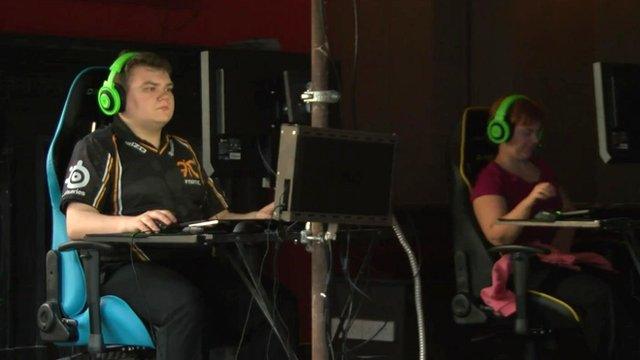Deliveroo: Making it easier to get a takeaway meal
- Published
- comments
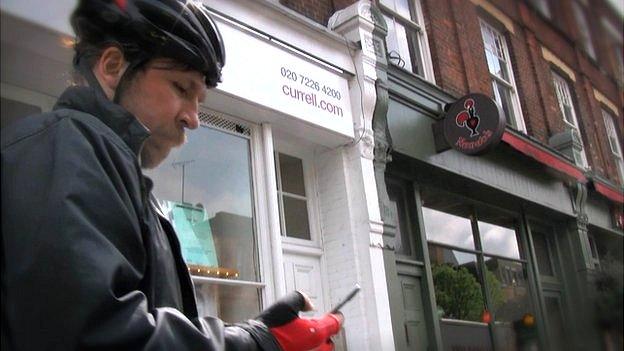
Destination Nando's: Mobile technology underpins Deliveroo's operation
A new food delivery business is trying to persuade more restaurants to embrace takeaway, by offering them the whole service on a plate.
"Two minutes to get to Nando's," says experienced cycle courier Rafal.
After a brisk ride through Islington in London, he tethers his steed, an electric bike, to a lamp-post outside the branch of the popular chicken eaterie.
After a brief absence, Rafal emerges with a box, consults a map on his smartphone, then rides for one minute to an address just around the corner.
A buzz on the intercom, and he disappears into the flat with his consignment of food.
Now you might be thinking, but Nando's doesn't deliver? You are right. That's where Rafal's employer comes in, a company called Deliveroo.
Street food
"I used to work in New York in investment banking," explains Deliveroo's founder Will Shu.
The 35-year-old is sitting in the metallic confines of Dishoom, a trendy London restaurant specialising in contemporary Bombay street food, which has signed up to Deliveroo.
"[At the investment bank] we had to order food in late at night all the time, and the options were very good. But when I moved to London in 2004, I found there to be a lack of quality takeaway.
"This idea [for Deliveroo] just stuck in my head for a long time, until I founded the company in 2012."

Will Shu, founder of Deliveroo, had been mulling the idea for many years
Like most other aspects of modern life, the food delivery business has been shaken up (or "disrupted" to use the current business buzzword) by internet technology.
In recent years online food delivery companies like Hungryhouse and JustEat have both established themselves as successful businesses in the UK.
"[But these] are what we call online marketplaces," says Mr Shu, "meaning they are not involved in the delivery of the food itself."
Firms such as JustEat sign up restaurants that already offer takeaway, then operate as an online hub, on which hungry members of the public can place their orders. Deliveroo goes one stage further, by also doing the delivery work for the restaurants.
"In our platform, all restaurants have to do is cook the food, and we take it and bring it to people, which means we can work with a higher class of restaurant."
On your bike
Back to Rafal, who is one of Deliveroo's most experienced cyclists.
Delivering Nando's by bike
A self-confessed cycle nut from Poland, he has just returned from a one-month trip pedalling around France for fun.
Does he think it is strange that someone can't be bothered to walk around the corner from his house to pick up a Nando's, and uses Deliveroo instead?
"I understand this," he says bluntly. "I'm also a computer programmer, sometimes when you are concentrating, you don't want distraction.
"You just want your favourite food at your desk. It's like ordering a pizza."

The food disruptors
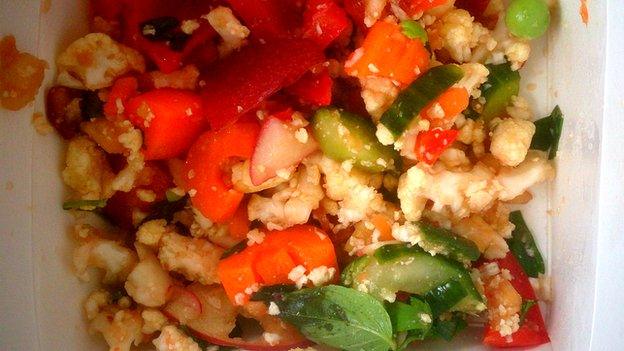
There is a rich mix of competition in the online food takeaway business
Dinein, external - Founded in 2012, a direct rival to Deliveroo in London and Brighton with a similar business model. Delivery charge is based on distance.
Meals, external - Founded in Bristol in 2012 and now also serving London, bills itself as 'posh nosh takeaway'. Another direct rival with the same business model. It charges £4.99 for deliveries under £15, going down to 99p for orders over £50.
City Pantry, external - Founded in 2014 and based in London. An online catering marketplace focusing on street vendors, delis and other places that wouldn't normally do takeaway. Focused on catering for events like weddings and office lunches.
GrubHub, external - American company founded in 2004 and listed on the US stock exchange. Operates in US and London, working with around 35,000 takeaway restaurants.
Muncherry, external - California business set up by busy parents in 2010. Its own chefs prepare fresh meals, to be warmed in the customer's microwave on delivery.
Blue Apron, external - American company that delivers "perfectly portioned ingredients" for customers to cook at home.

Persuasive challenge
Back at Dishoom a tablet computer sits in the kitchen, synced to Deliveroo's app. This is how the restaurant's chefs know when new takeaway orders come in, and the same system alerts the couriers.
Of course there is still a stigma attached to being a restaurant that does takeaway, serving food in boxes instead of on plates.
Deliveroo itself boasts on its website that it does not sign up "low-quality takeaway restaurants".
Yet Mr Shu admits that it can be a challenge to persuade more expensive restaurants to sign up.
The quid pro quo is that they get more custom - attractive to a restaurant like Dishoom, which is off the beaten track.
And the restaurants have minimal risk, as the overheads of the takeaway business are in effect outsourced to Deliveroo, which charges the eateries a percentage of the order value.
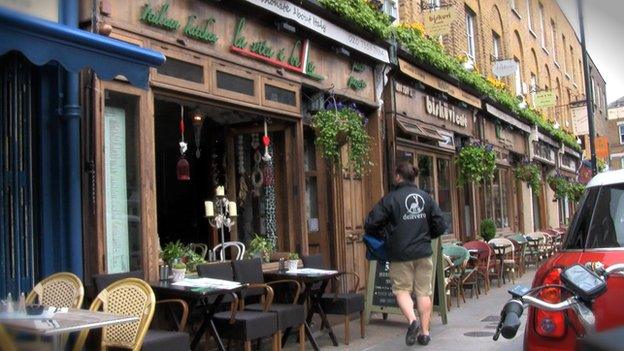
Target business customers are bistros that would not normally deliver
It's an attractive formula made more feasible by mobile, internet technology. Direct competitors like Dinein, external and Meals, external have spotted the same gap in the market.
The cost for members of the public using Deliveroo is menu price plus £2.50 (as long as the order is over £15, below and the fee goes up to £4.50).
Is this perhaps more in line with an investment banker's lunch budget?
You can share with colleagues points out Mr Shu, so if five people order food, then it's only 50 pence each.
Of course most dedicated takeaway restaurants offer free delivery.
Baby steps
Rafal's next bike mission is from the Dishoom restaurant. The job info appears through an app on his mobile phone - he is able to read it despite a heavily cracked screen. An occupational hazard, he says with a smile.
Delivering this one involves a longer cycle, with some generous inclines, to Upper Street in the heart of the Islington.
After a short period of confusion, involving map re-checking and a phone call, he establishes the correct door in the Georgian terrace. There is a tense wait, before a woman appears at the door.

This customer used the service as she was busy looking after a baby at home
Why did she choose this method?
"I've got a six-month-old baby asleep upstairs in his cot, so I couldn't leave the house," she explains. "I might end up just eating cereal or toast, because I'm a busy mum, Deliveroo means I can have a proper meal."
Who eats?
Geography determines the kind of person calling on their services, says Mr Shu. He says that in the Mayfair area of central London, the typical customer is a hedge fund business, while in east London it is a lot of single people, and in Chelsea, west London, it is typically families.
He reckons it's about two-thirds dinners, one-third lunches.
The company does not disclose its number of orders or turnover, but the service has grown quickly since 2012, and now also operates in Brighton, Oxford, Cambridge, Reading, Manchester, Birmingham, Bristol, Nottingham, Edinburgh and Glasgow.
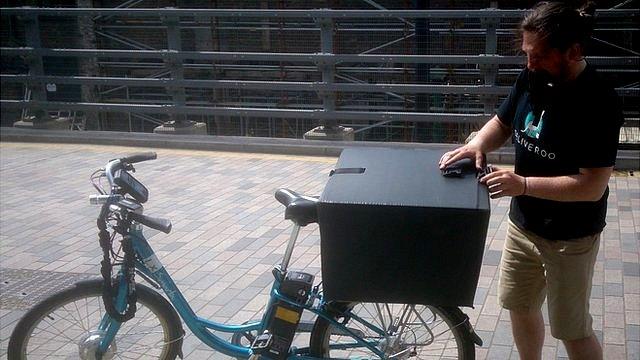
Rafal, one of more than 700 Deliveroo drivers in London, loads up his electric bike
And outside the UK, it branched out into Dublin and Berlin earlier this year.
"We plan on being in 30 cities by the end of the year," says Mr Chu.
With stiff competition, that kind of growth will depend on getting the right price points for the business model.
And of course there is the danger that in the midst of summer, many people will prefer to take a pleasant stroll to go and get their own food.
Watch the video report about this story here.
- Published1 August 2013

- Published8 June 2014
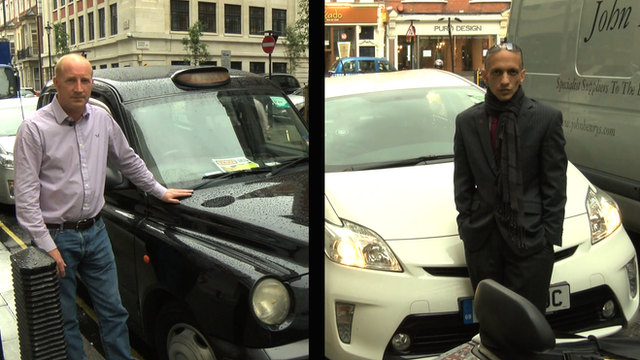
- Published26 June 2013
